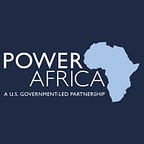Public-Private Partnerships to Drive Domestic Infrastructure Projects?
[W]hat I heard the President say last night is a public-private partnership idea, which we’ve already been doing. USAID put $8 billion up and attracted more than $45 billion in a public-private partnership called Power Africa… That principle can work in our infrastructure. Isn’t it interesting that we have a business guy in the White House talking about real business solutions about infrastructure? And he knows how important infrastructure is for growing the economy.
– Republican Senator David Perdue of Georgia, speaking with MSNBC’s Chuck Todd following President Trump’s speech to Congress about the proposed $1 trillion dollar U.S. infrastructure program. See https://www.youtube.com/watch?v=1d0CNyHV-34 at minute 5:52.
Power Africa certainly appreciates the fact that Senator Perdue cited us as a model for the U.S. government’s use of public-private partnerships for domestic infrastructure projects. Let us shed a little more light on the numbers.
The 57 power projects (6,500 megawatts total) that have reached financial close with Power Africa support are worth more than $14 billion. The $8 billion Sen. Perdue refers to above is the commitment U.S. government agencies made to Power Africa; but committed dollars are much different than disbursed dollars. Power Africa currently estimates that we have spent no more than a few hundred million dollars to support those projects — a leverage ratio of approximately 50:1 of private funding to public funding.
Earlier this month, Congressman Ed Royce (R-CA) reconfirmed his commitment to Power Africa by delivering the keynote address to open the EnergyNet Powering Africa Summit. His remarks reinforced congressional support through the Electrify Africa Act, and he commended our efforts to alleviate poverty in Africa by providing access to electricity. In reference to Power Africa’s success in leveraging private capital in support of the Electrify Africa Act, the Chair of the House Committee on Foreign Affairs said, “We’ve got over $14 billion since passage of legislation deployed into Africa and our goal is, of course, to increase this.” More details on Congressman Royce’s remarks are available in this Devex story.
Natural gas projects lead the way, contributing 4,819 MW to that total, with the balance from wind (810 MW), solar (558 MW), hydro (145 MW), geothermal (140 MW), heavy fuel oil (86 MW), and biomass (8.5 MW). Three-fourths of our MW total comes from gas projects, and three-fourths of the 57 projects involve renewables. In terms of connections, we now stand at 8.8 million, with the vast majority in lanterns (6.6 billion), but also 2 million in household solar, 2,420 in mini-grid, and 190,510 in on grid connections. That means we have reached 44 million people in Africa so far.
On the fringes of the Powering Africa Summit, Power Africa hosted Partnership Week, which gave us the chance to celebrate our more than 140 partners from more than 20 countries, and especially our 64 U.S. private sector partners who have operations across the United States. We are thrilled to have been able to reach out directly to many of these partners at our speed networking session with the Power Africa interagency team. The attached maps demonstrate the breadth of our partnerships and highlight some of our early successes in supporting exports and jobs in the United States.
We also convened a Development Partners’ Meeting during Partnership Week with senior representatives from the World Bank Group, African Development Bank (AfDB), United Kingdom, Norway, Sweden, Japan, France, Canada, the European Union, and the Development Bank of Southern Africa. We discussed how better to coordinate energy initiatives, positions on competitive procurement, and ways to better work with African governments to increase the number of projects reaching financial close. At the meeting, we previewed Power Africa’s Toolbox 2.0, which now features the many robust mechanisms our development partners offer to support access to electricity in Africa, including project preparation tools, equity and debt finance, and technical assistance covering all stages of project finance. We will publish the final version of Toolbox 2.0 on our website once we incorporate feedback from our development partners.
At the EnergyNet Powering Africa Summit, Power Africa commemorated International Women’s Day by hosting a session on the business case for promoting gender diversity in the energy sector, led by Acting U.S. Trade and Development Agency Director Enoh Ebong. Speakers highlighted Ernst and Young’s Talent at the Table, a report on women in power utilities that consistently finds that the top 20 most diverse utilities significantly outperform the lower 20 in terms of return on equity.
We joined select EnergyNet sessions featured Ministers of Energy and other senior officials from Botswana, Democratic Republic of the Congo, Rwanda, Senegal, South Africa, and Uganda in discussions with the private sector and development partners on topics such as gas IPPs, sub-regional energy cooperation, and ways to attract private finance for energy projects in Africa. Power Africa also organized a series of breakout sessions to discuss energy transactions in Ghana, Rwanda, Senegal, and Uganda.
At the conclusion of the summit, State Department Acting Special Envoy for the Bureau of Energy Resources Mary Warlick co-hosted, along with many other agency heads, our high-level African visitors at the State Department for a lunch with the Power Africa interagency team to discuss challenges and successes in bringing electricity to Africa.
Power Africa has become a model of interagency and international collaboration to leverage private sector investment for development. Like all of you, we continue to work through budget scenarios. But one thing is clear already. Now is the time to redouble our efforts, not retrench. We have demonstrated our effectiveness in enabling the private sector where market imperfections exist as we also help our African partners achieve their development goals while promoting American interests at home and abroad. Our team feels proud to be part of this win-win for development assistance.
